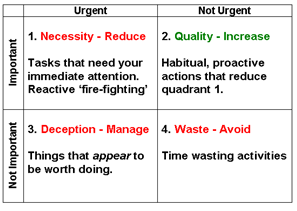
This call does have a possibility of stretching for maybe an hour or two you could have spent the time working on that very important project. For example, you are at work, and you get an important call from home. You can afford to be a little carefree, but don’t let that get to your head more often.Īccording to experts, this time management quadrant is all about being aware of the vital influence of one thing’s relation to another.


According to this quadrant, you have to remain vigilant.

Therefore, the project manager, in question, does not feel “threatened” or under pressure to get things done.Įventually, procrastination leads to failed targets. You can say, these issues are deadline-oriented – and that deadline may be stretched months apart. A lot of issues are time-dependent they are not imperative or critical in that sense. This quadrant is about maintaining focus on time managing and planning. Since you know or have the inkling about the possible outcomes, you can be in the position to shift the odds in your favor.Ģ. These scenarios are under your control because your work and actions determine the outcome.Ĭritical tasks are always on high priority as they impact you immediately. On the second hand, if you’re running out of time on a project that has the possibility of impacting your position at the company, this scenario can be classified as a Critical scenario. These things are imperative and can happen to anyone at any given time in life. Take a look at some of the important aspects of the time management matrix.Ĭertain things happen unexpectedly such as, but not limited to accidents, critical scenarios, and other extremely unpleasant incidences. After analyzing the crux for these two elements, we can apply the concept in our lives and set things straight as far as work is concerned. the urgency of the substance and of course the correlation between time management and its impact on your work. Once you get the hang of it, you will be able to work efficiently in the long run.įirst, we have to understand that there are two main parts of this discussion – i.e. Don’t worry, this is not a complex concept. It does have its consequences eventually, and that’s why it is super important to be aware of the 4 quadrants of the time management matrix. The priority and order of doing tasks are sometimes overlooked. It is human nature that we prefer doing things that are urgent regardless of foreseeing their fruitfulness. As a result, the pace of doing things and results vary accordingly. Therefore, this means that everyone does things according to their perception. It is living and being driven by the principles you value most, not by the agendas and forces surrounding you." Habit 1 says, "You're in charge.The tendency of doing things varies from person to person. " Putting first things first means organizing and executing around your most important priorities.

Why is it important to put first thing first? Covey, it's based on the the idea that all your time is spent in a four quadrant matrix.īeside above, what did Stephen Covey die from?
#Stephen covey time management matrix how to
It's a particularly useful tool if you want to know how to prioritize work, personal roles, goals and commitments. Subsequently, question is, what is the Time Management Matrix? The time management matrix will help you identify what you really spend your time on. Covey popularized the Eisenhower's Time Management Matrix in his book The 7 Habits of Highly Effective People, stating that we live a fourth generation of time management, more effective, in which managing time itself is no longer the aim, but managing where to focus at any particular time. Similarly, what is Stephen Covey's Time Management Matrix? He writes: “Quadrant II is the heart of effective personal management. Covey advocates spending the majority of our time in Quadrant II (not urgent and important), as the foundation of a productive and fulfilling life. What Stephen Covey Taught Me About Prioritizing.


 0 kommentar(er)
0 kommentar(er)
